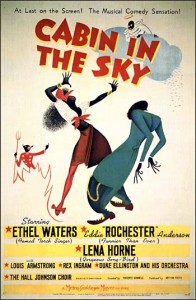Get the popcorn ready. The curtain is about to go up on Kid Ory, Lionel Hampton and Louis Armstrong. This week we take a look at some of the world’s top jazz artists who not only provided music for Hollywood movies, but appear on the silver screen as well.
Scott Yanow, author of Jazz on Film, joins David Holt in the studio to talk about the great—and sometimes not so great—Hollywood movies featuring high-level jazz performances on camera. We've provided links online to video clips of rare big-screen appearances by iconic figures who continue to inspire Jim Cullum and the Band, including Fats Waller, Billie Holiday, Hoagy Carmichael and Louis Armstrong. Along the way we hear from frequent guest Dick Hyman about what it's like to compose music for Woody Allen movies.
Scott Yanow notes that movies and jazz "were both in their infancy in the 1890s and grew up together," but says that "over 80 years later, it can be argued that Hollywood has yet to make a truly great jazz film despite many memorable moments on the big screen." Yanow guides us through this uneven thicket to discover what's worth watching from a jazz fan's perspective.
Songwriter, singer and pianist Hoagy Carmichael is one of the few artists to appear totally at ease on film. Carmichael created a recognizable, archetypical persona in the movies, typecast as a singing piano player with a hat on the back of his head and a cigarette dangling from his lip. One of his most memorable roles is as "Cricket," Lauren Bacall's piano player, in the WWII classic To Have and Have Not. Hoagy's tune "How Little We Know," introduced in a waltz-time (3/4) version in the film by a sultry Bacall, has been a favorite of Jim and the Band in 4/4 swing time.
When it comes to depicting the life story of famous jazz musicians, Hollywood has had a hard time of it. Bio-pics, as a genre, come under fire for everything from bad acting to gross inaccuracies in plot points. The 1959 Red Nichols bio pic, The Five Pennies, is an exception. Nichols ghosts for Danny Kaye on cornet and Louis Armstrong lights up the screen in every scene he appears in. Yanow rates this film a 9 out of possible 10 points, making it a very worthwhile view.
The Benny Goodman Story from 1954 gets an 8 from Yanow for the music. Much of the story is wildly fictitious but the music and musicians make it fun to watch. Benny Goodman provides the clarinet tracks for Steve Allen; and there are appearances by Lionel Hampton, Gene Krupa, Teddy Wilson and Ben Pollack, all of whom have lines.
A trio of landmark, big-budget films with all-Black casts are well worth viewing not only for their historical value. Despite overacting and some outrageous stereotypes, the 1929 film Hallelujah features a rare glimpse of Curtis Mosby’s Blue Blowers playing hot jazz, and blues singer Victoria Spivey has an acting role. The film rates only a 5 in Yanow's system but the music gets an 8.
The 1942 Cabin the Sky is one of the all-time great Black musicals. Star turns by Ethel Waters and Lena Horne; music by the Duke Ellington Orchestra and a brief appearance by Louis Armstrong make this one a must-see. Eddie "Rochester" Anderson plays the lead and the dance team Buck and Bubbles and the Hall Johnson Choir also appear.
The 1943 Stormy Weather rates a 9 from Yanow for the music. The story follows the tale of a fictional tap dancer, played by Bill Bojangles Robinson, and his love interest played by Lena Horne. Fats Waller gets off some great stride piano and packs a punch in only ten minutes on screen. In the clips below, Lena Horne famously sings the title track and Cab Calloway displays his trademark frenzy, and the Nicholas Brothers steal the show with their spectacular stair dance routine to "Jumpin' Jive."
Here are some other cinematic jazz gems:
New Orleans, 1947, with Louis Armstrong, Billie Holiday, and bandmembers Barney Bigard, Kid Ory, Zutty Singleton and Red Callander performing "Where the Blues Were Born," and "Farewell to Storyville."
Pete Kelly's Blues, 1955, with Dragnet's Jack Webb and Ella Fitzgerald performing "Hard-Hearted Hannah."
Photo credit for Home Page: Jazz on Film by Scott Yanow, Image courtesy the author.
Text based on Riverwalk Jazz script by Margaret Moos Pick ©2012



